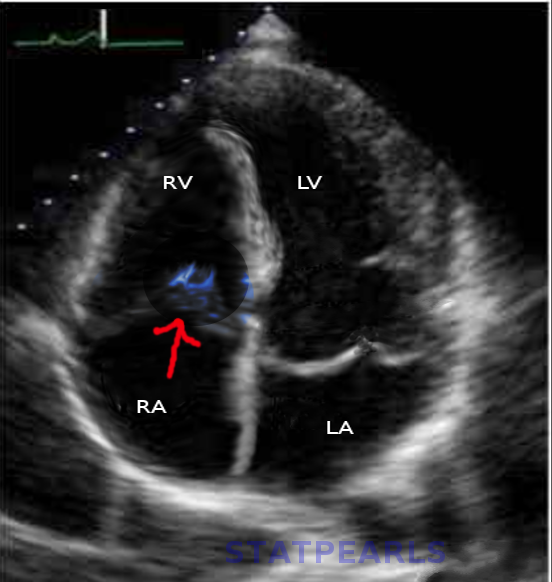[1]
Hussain ST, Witten J, Shrestha NK, Blackstone EH, Pettersson GB. Tricuspid valve endocarditis. Annals of cardiothoracic surgery. 2017 May:6(3):255-261. doi: 10.21037/acs.2017.03.09. Epub
[PubMed PMID: 28706868]
[2]
Wurcel AG, Anderson JE, Chui KK, Skinner S, Knox TA, Snydman DR, Stopka TJ. Increasing Infectious Endocarditis Admissions Among Young People Who Inject Drugs. Open forum infectious diseases. 2016 Sep:3(3):ofw157
[PubMed PMID: 27800528]
[3]
Chambers HF, Korzeniowski OM, Sande MA. Staphylococcus aureus endocarditis: clinical manifestations in addicts and nonaddicts. Medicine. 1983 May:62(3):170-7
[PubMed PMID: 6843356]
[4]
Fruauff AA, Barasch ES, Rosenthal A. Solitary myeloblastoma presenting as acute hydrocephalus: review of literature, implications for therapy. Pediatric radiology. 1988:18(5):369-72
[PubMed PMID: 3050842]
[5]
Hansen JB, Jagt T, Gundtoft P, Sorensen HR. Pharyngo-oesophageal diverticula. A clinical and cineradiographic follow-up study of 23 cases treated by diverticulectomy. Scandinavian journal of thoracic and cardiovascular surgery. 1973:7(1):81-6
[PubMed PMID: 4632890]
Level 3 (low-level) evidence
[6]
Dinubile MJ. Heart block during bacterial endocarditis: a review of the literature and guidelines for surgical intervention. The American journal of the medical sciences. 1984 May-Jun:287(3):30-2
[PubMed PMID: 6731477]
[7]
De Castro S, Cartoni D, d'Amati G, Beni S, Yao J, Fiorell M, Gallo P, Fedele F, Pandian NG. Diagnostic accuracy of transthoracic and multiplane transesophageal echocardiography for valvular perforation in acute infective endocarditis: correlation with anatomic findings. Clinical infectious diseases : an official publication of the Infectious Diseases Society of America. 2000 May:30(5):825-6
[PubMed PMID: 10816155]
[8]
Torres-Tortosa M, de Cueto M, Vergara A, Sánchez-Porto A, Pérez-Guzmán E, González-Serrano M, Canueto J. Prospective evaluation of a two-week course of intravenous antibiotics in intravenous drug addicts with infective endocarditis. Grupo de Estudio de Enfermedades Infecciosas de la Provincia de Cádiz. European journal of clinical microbiology & infectious diseases : official publication of the European Society of Clinical Microbiology. 1994 Jul:13(7):559-64
[PubMed PMID: 7805683]
[9]
Gould FK, Denning DW, Elliott TS, Foweraker J, Perry JD, Prendergast BD, Sandoe JA, Spry MJ, Watkin RW, Working Party of the British Society for Antimicrobial Chemotherapy. Guidelines for the diagnosis and antibiotic treatment of endocarditis in adults: a report of the Working Party of the British Society for Antimicrobial Chemotherapy. The Journal of antimicrobial chemotherapy. 2012 Feb:67(2):269-89. doi: 10.1093/jac/dkr450. Epub 2011 Nov 14
[PubMed PMID: 22086858]
[10]
Nishimura RA, Otto CM, Bonow RO, Carabello BA, Erwin JP 3rd, Guyton RA, O'Gara PT, Ruiz CE, Skubas NJ, Sorajja P, Sundt TM 3rd, Thomas JD, ACC/AHA Task Force Members. 2014 AHA/ACC Guideline for the Management of Patients With Valvular Heart Disease: executive summary: a report of the American College of Cardiology/American Heart Association Task Force on Practice Guidelines. Circulation. 2014 Jun 10:129(23):2440-92. doi: 10.1161/CIR.0000000000000029. Epub 2014 Mar 3
[PubMed PMID: 24589852]
Level 1 (high-level) evidence
[11]
Ortiz-Bautista C, López J, García-Granja PE, Sevilla T, Vilacosta I, Sarriá C, Olmos C, Ferrera C, Sáez C, Gómez I, San Román JA. Current profile of infective endocarditis in intravenous drug users: The prognostic relevance of the valves involved. International journal of cardiology. 2015:187():472-4. doi: 10.1016/j.ijcard.2015.03.368. Epub 2015 Mar 27
[PubMed PMID: 25846656]
[12]
Martín-Dávila P, Navas E, Fortún J, Moya JL, Cobo J, Pintado V, Quereda C, Jiménez-Mena M, Moreno S. Analysis of mortality and risk factors associated with native valve endocarditis in drug users: the importance of vegetation size. American heart journal. 2005 Nov:150(5):1099-106
[PubMed PMID: 16291005]
[13]
Mocchegiani R, Nataloni M. Complications of infective endocarditis. Cardiovascular & hematological disorders drug targets. 2009 Dec:9(4):240-8
[PubMed PMID: 19751182]

